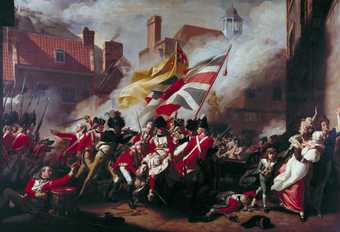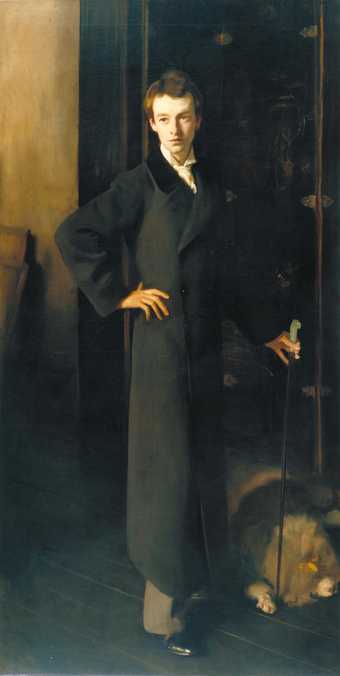American painting began with the works of a few obscure artists who doubtless drifted to the New World through inability to succeed in the Old. The first painting to impress itself on the visual memory is Dean Berkeley and his Entourage, an ambitious but clumsy conversation-piece done in 1729 by John Smibert (1688–1751), a Scotsman, the most gifted of these early immigrant journeymen. The first native-born painter of note was Robert Feke (c.1705–c.1750), whose Portrait of the Isaac Royall Family is dated 1741. When this stiff, conscientiously finished ‘primitive’ was painted there lay already in their cradles two infants, the one in remotest Pennsylvania, the other in Boston, who, in the space of a few years, were to bring American painting out of its provincial condition and themselves to become figures of European celebrity; they were Benjamin West (1738–1820) and John Singleton Copley (1737–1815).

Fig.1
John Singleton Copley
The Death of Major Peirson, 6 January 1781 1783
Tate N00733
West, grotesquely over-praised in his lifetime, has since been obscured by a scarcely more merited neglect. The time is overdue for a more considered evaluation of his art. He too often appears a dry lack-lustre person, but he possessed qualities which will, in the end, attract a lively attention from the long indifferent eyes of critics and scholars. First, his sense, often latent but on occasion piercing, of actuality, which is recurringly revealed in his less famous works and has been recognised in his admirable Colonel Guy Johnson, of about 1779, and the more celebrated Death of Wolfe of 1770. West’s portrayal of the dying hero and his companions in contemporary clothes instead of the attire of classical antiquity caused a sensation when it was exhibited, and established, though, of course, it did not initiate, a new convention. In such pictures, however, as the early The Wife of Arminius before Germanicus and Cyrus and the Family of Astyages, both of 1772, he shows a comprehension, uncommon among painters in England, of the classical art whose conventions he could so boldly disregard. The Death of Bayard, of 1771, shows another manifestation of his insight into different modes of seeing; for it might be taken, by anyone ignorant of its date, for an illustration to a novel by Scott, so suffused is it with the spirit of mediaevalizing romanticism. Copley was a less various but a much more consistently effective artist. American critics, justly proud of the relentlessly probing interpretations of character which distinguish his early Boston portraits – portraits of sitters willing to pose for as long as the painter desired, and proudly content to be portrayed without flattery, ‘just as they were’, have shown a disposition to decry the pictures of ‘history’ to which Copley principally devoted his powers after he had settled in England. It would not be surprising if the present exhibition were to lead to a revived appreciation of the command of intricate design, the suave yet audacious handling of paint, the limpid colour and the noble sense of the heroic manifest in The Death of the Earl of Chatham and The Death of Major Pierson [sic]. A younger contemporary, who though he studied in London did not remain there permanently and was never decisively affected by the current tradition of English painting, was Gilbert Stuart (1755–1828), who brilliantly developed a broad, realistic vision which has much in common with that of Raeburn.
After the passing of the generation of West, Copley and Stuart no painter of comparable rank made his appearance in America. This illustrious generation, however, was linked with a subsequent age by the elegant Thomas Sully (1783–1872) whose melting portrait of Queen Victoria1 at the time of her accession conveys to perfection, if not her exact likeness, at any rate the sentimental aura with which she was surrounded.
As in England the early 19th century was a time when painters were moved with a special intensity by the beauty of landscape. The highly romantic idealism which found its characteristic expression in the work of Washington Allston (1779–1843) gradually yielded to the milder romantic realism of George Inness (1825–1894) and the members of the Hudson River School.

Fig.2
John Singer Sargent
W. Graham Robertson 1894
Tate N05066
The remarkable generation which may be said to be linked by the long-lived Sully with that of Copley and West consisted of six painters, of whom three, while retaining with pride their American citizenship, became members of foreign schools of painting, and three worked almost exclusively in their native land. The works of James McNeill Whistler (1834–1903), Mary Cassatt (1845–1926), John Singer Sargent (1856–1925) are a princely contribution by America to the art of Europe. The three who stayed at home, Winslow Homer (1836–1910), Thomas Eakins (1844–1916) and Albert Pinkham Ryder (1847–1917), although their attainments are not less memorable, have remained outside their own country almost unknown. I myself shall not forget the shock of pleasure with which, years ago, at an American university, I first saw a small reproduction of Ryder’s Mary Magdalene and recognized the work of a master. ‘Ryder sought to embody in his paintings,’ write two contemporary American scholars, ‘what Herman Melville ... had sought to describe in words – in fact few painters and authors have been spiritually so akin. The mystery and the elemental forces of the sea, the loneliness of sailing under windswept, moonlit skies, the terror that emanates from certain landscapes, from spellbound valleys and gaunt trees silhouetted against stormy clouds.’2 Ryder’s kingdom was of the imagination, Eakins’s was of the actual world. It was man, and for preference contemporary man in his most active moments, that afforded the themes most appropriate to the austere and energetic art of Eakins an art in which a combination of relentless observation with a kind of Positivist sympathy plays a major part. Eakins was the American Courbet. ‘I never knew of but one artist, and that’s Tom Eakins, who could resist the temptation to see what they thought ought to be rather than what is,’ declared Walt Whitman.
In the painting of America as in that of Europe during the period which ended with the death of Eakins two contrasting visions, a realistic and a poetic, can be clearly distinguished. The predominance of the first is evident; indeed Ryder is the sole imaginative painter of genius.
About American painting of the present day even such bald generalizations are impossible. The impression it makes upon the visitor from Europe is one of overwhelming variety: every conceivable movement, even every European national tradition, has its exponents and the Americans would justly claim that all such legitimate and inevitable influences have been individualized by a peculiar freshness of the intellectual and artistic climate in the United States, just as in the 18th century, the influence of English portraiture was not absorbed without a native contribution of a more rugged naturalism than was practised in London.
The present Exhibition – perhaps the most representative collection of American painting ever assembled, containing as it does masterpieces from America and Great Britain never before hung side by side – will give the people of Great Britain a unique opportunity of becoming acquainted with a fascinating and rapidly developing school of painting hitherto scarcely known among us.
The Trustees of the Tate Gallery feel the more honoured to be the instrument of this opportunity as it is one of which America has taken the most generous advantage, not hesitating to send us, at the request of the diligent Committees appointed by the Washington Gallery, their most valuable examples of the National school.
